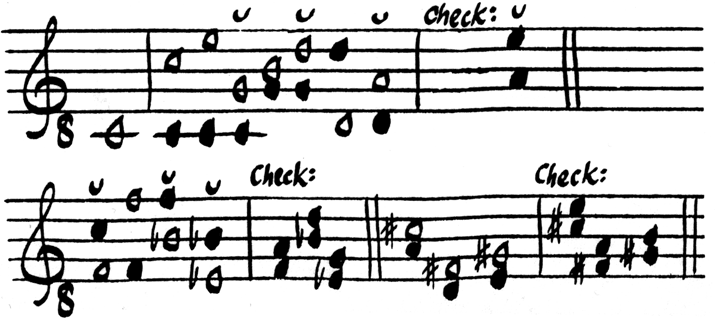
 |
2.2.1: consonances
If you want to play music in which the thirds are important - as they were from c.1400 - you need thirds which are in tune: but, as you can hear from your Pythagorean tuning, the a which is in tune together with an f is quite a different note from the a you get if you tune four pure fifths f-c-g-d-a. When singing, or playing a flexible-pitch instrument, you can produce as many different a's as the context demands and stay in tune the whole time - though it must be obvious that you can't also keep a stable pitch, of course: but on a fixed-pitch instrument you have a problem. There have been plenty of experiments with keyboards having complex numbers of keys within an octave
click for a closer view! |
|
fig. 1 & 2: from Marin Mersenne, Harmonie Universelle, Paris, 1636 (Livre 6, p.357, 352)
but the consensus of opinion has always been that more than twelve is too clumsy, and that a compromise is necessary - an adjustment or temperament (Lat., 'a proper measure').
Pythagorean thirds are too sharp, and quite a lot too sharp at that, so to get them in tune you have to lower them. If you simply lower the a, for example, (ex.3 again) then all you have done is to make the fifth, d-a, as badly out of tune as the Pythagorean third was. But, if you remember, you arrived at that Pythagorean third by building up four 5ths one above the other: so you could instead share the burden equally, lowering each note so that each 5th is a bit flat - only one quarter as much out of tune as the Pythagorean third was. Most musicians have accepted that much out-of-tuneness, and many people don't notice it as out-of-tune at all - it's largely a question of getting used to how it sounds.
Thomas de Sancta Maria (1565):
'You have to leave the fifth a tiny bit flat, and the flatness is so tiny that it is as if it were invisible: it can be explained no better than by this expression, "it is, it isn't!" (2a. parte, fo.122v.)
Marin Mersenne (1636):
'Organists and organ-builders with knowledgeable and sensitive ears consider the fifths to be tempered as they are supposed to be when they beat so little that it is hard to tell that they are beating at all.' (Livre 6, 366-8)
Quantz suggested that orchestral violinists should tune their open strings to the harpsichord's tempered fifths, and that makes sense today too:
J.J. Quantz (1752):
'To tune the violin quite accurately, I think you will not do badly to follow the rule that must be observed in tuning the harpsichord... For if all the fifths are tuned...true... only one of the four strings will be in tune with the keyboard ... (Chap.XVII, vii, 4)
but the way he expressed it makes it clear that it was not normal to do so, and pure and tempered fifths must have been accepted side by side:
This suggestion is not presented as an absolute rule, however, but only as a matter for further reflection.' (the same)
We can now tune all twelve notes in the octave using pure 3rds and slightly-flat 5ths, following for example Pietro Aron's method (1523): as notated here the white note is the one you tune to the previously-tuned black one.
 |
* there will be sound examples here soon *
Marin Mersenne:
'The little curled-up line is already used for showing a short syllable, so it can be used here to show the weak and diminished fifths: u'
'You could start on any note you like; and if your ear is proportioned to higher notes, you can tune an octave higher. You can also tune to thirds instead of fifths, but you need a better ear.' (Livre 6, pp.364-6)
ex.7: Mersenne's 'weak' fifths
![]()
|